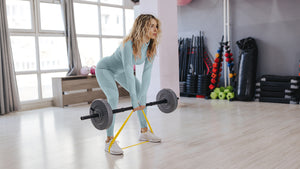When you get into lifting, you usually start in one of these two camps: resistance bands or weights. While it’s fun to have an opinion of one over the other, we believe both have their place in your strength training routine. Merging a dumbbell workout with a resistance band workout is ideal for correcting imbalances, developing strength throughout the body, and giving you the best overall gym experience.
PVL is here to give you the most effective full-body workout. Are you ready?
Resistance Bands
To some lifters, they think resistance bands don’t offer enough resistance to warrant even using them. However, this stigma isn’t true. With the proper exercises and lifting technique, resistance bands can provide the toughest stimuli a gym can offer.
The beauty of resistance bands is the varying resistance at different points of the repetition. For example, if you did a standing chest press with a resistance band wrapped around your back and connected to a barbell in front of you, the resistance is more strenuous the closer the bar is to your body. As you press the bar away from you, the resistance lightens as your arms get farther away from your body. This makes sense from a physiological point of view.
Combining intense resistance with varying levels depending on the resistance point, you get to work on different ranges of motion, gaining strength on every plane. This reduces weak spots and creates a well-rounded physique.
Another pro of using resistance bands is they can make it easier to do specific calisthenics movements. Pull-ups and dips come to mind as exercises where you can stand on a resistance band to lessen your body’s weight. In addition, bands are easily portable, allowing you to get an aggressive workout while traveling.
Weights
Dumbbells and barbells are terrific tools for an effective workout. For one, you can easily track where you are with your lifts so you can progressively overload (the key to hypertrophy or muscle growth). For two, moving dumbbells through space is safe and applicable to the real world. Lifting a box and carrying it somewhere indicates a dumbbell deadlift and curl. And if you were to go to failure with dumbbells, they can quickly drop to the floor without hitting your body.
The big reason to use weights is they can get heavy. Which means you can gain incredible strength over time. Resistance bands can offer some intense loading, but nothing beats 100-pound dumbbells.

Dumbbell & Resistance Band Workout
Here are the exercises to do to combine resistance bands and dumbbells to create the ultimate strength and muscle-building workout:
The first two exercises focus on the chest and triceps. For the triceps pushdowns, wrap the resistance band over a sturdy overhead bar and press straight down, focusing on a squeeze in the triceps.
The following two exercises are for the posterior muscles (back). Use the resistance bands to ease the load until you can do bodyweight pull-ups. You’re planking with dumbbells in your hands for renegade rows, alternating rowing the dumbbells to your torso while stabilizing your body.
You need a strong resistance band for shoulder press underneath your feet and held in your hands. This is a standing shoulder press, so if you have too weak of a band, it could snap at your feet and seriously injure you. So, only do this if your band is super strong. If you have one, this is an excellent way to train shoulders without injury due to the varying resistance throughout the movement.
The last four are lower body movements, targeting the quads, hamstrings, and glutes. For resistance band squats, the key is to flex your knees out to maintain force on the band. This helps with stabilization strength in your quadriceps and hamstrings. The last two exercises are for the posterior chain, so squeezing at the top of the movements for a solid second is helpful for injury-proofing and developing serious muscle mass.
Combining resistance bands and dumbbells allows you to develop an aesthetic body that will be strong for years to come.
Article by Terry Ramos

